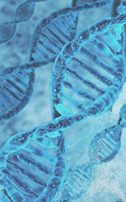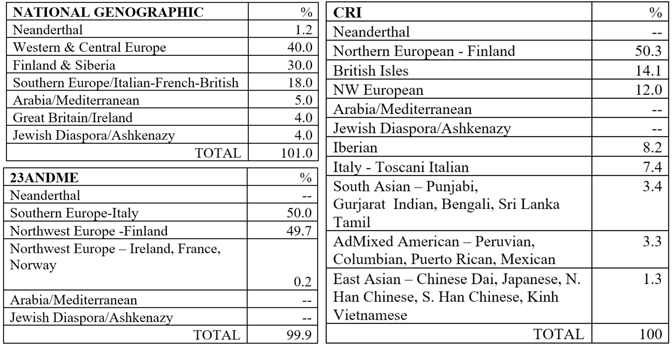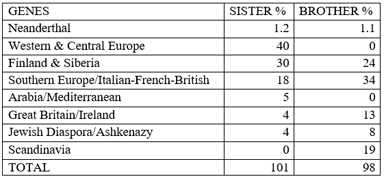Genealogy and Genetics
Who We Really Are
by Joelle Steele
 A common stumbling block in genealogy is when DNA does not match the nationalities of one's parents. The reason for this is very simple: genealogy and genetics are two completely different things. Genealogy is about nationality, the history of the people who form multiple generations of a family. Genetics is about biology, the chemical make-up of a living entity.
A common stumbling block in genealogy is when DNA does not match the nationalities of one's parents. The reason for this is very simple: genealogy and genetics are two completely different things. Genealogy is about nationality, the history of the people who form multiple generations of a family. Genetics is about biology, the chemical make-up of a living entity.
DNA is ancient and it predates any genealogical history a person may have, because DNA goes back not hundreds of years, not even thousands of years, but tens and hundreds of thousands of years, back to the earliest living humans. In that way, genealogy is about the origins of a single family while genetics is about the origins of humankind that we all carry in our biology.
Human DNA is divided into 23 pairs of large parts called chromosomes. The 23rd pair determines whether a person is male or female. Each chromosome is divided into smaller parts called genes. Each chromosome can carry hundreds or even thousands of genes. The genes determine how a body grows and functions and are responsible for the color of skin, hair, and eyes; height; face shape; face features; susceptibility to certain diseases; tastes for certain foods; athletic ability; etc. The genes determine all these variations among people. They indicate where a person's ancestors once lived tens of thousands to millions of years ago. The autosomal method of DNA testing is used to determine the combination of different ethnicities carried in a person's genes.
DNA testing is readily available from a variety of labs. But don't assume that the results will be the same. They will be accurate, but what they reveal is based mainly on three things: 1) the method used for collecting the DNA sample (cheek swab is most accurate); 2) how far back the testing goes (some companies only go back five generations and others go back 200,000 years or more); and 3) how many SNPs (single nucleotide polymorphisms, pronounced "snips") are used in a test. I have had my DNA tested by three labs to see if the results were the same. I was very surprised to see how different they were. So, your genetic make-up will look different depending on the methods used by the lab that analyzes your DNA. To illustrate the differences, here are my results from three different labs:

The interpretations are different because many labs assign different names to groups of people. For example, in the test results above, National Genographic says I am 30% Finnish/Siberian, while CRI says I am 50.3% Northern European-Finland, and 23andme says I am 49.7% Northwest European-Finland. No consistency there. And that's just one difference among the three labs.
When it comes to DNA, many people are surprised, some utterly shocked, at what their genetic profiles reveal about their biological ancestry. This is because their genetics form a less-than-perfect match with what they know about their nationality. DNA proves that no one is ever a “pure” anything - especially "white," which represents only 15 percent of the world, and only 5 percent of North America. And, that white population is decreasing, with projections that in about 35 years the world's white population will be reduced to about 10 percent.
While doing his genealogy, one of my friends who is about as white as you can be in appearance, was surprised to discover that his maternal great-grandparents were black. This confirms recent genetic studies which indicate that there are no genetically distinct races at all, just one single race: the human race, with a lot of variations. When you have your DNA profiled, you'll understand that.
Another thing about DNA that surprises people is how different their DNA is compared to that of their siblings. In terms of nationality, my brother and I are both half-Swedish and half-Italian. But, this doesn’t mean much when you look at our DNA profiles (below). My brother's DNA is very different than mine.

Most people assume that if they have their DNA profile done, their sibling's DNA profile will be the same. After all, they do have the same parents. But DNA profiles of siblings are different because every time a child is born he or she carries DNA from both parents, but each sibling carries it in different amounts and combinations. This re-shuffling of the parents' DNA is called genetic recombination (recombinant genes). That means that, on average, siblings share only about 50% of the same DNA. And, in fact, that is the exact amount that my brother and I have in common. This difference in shared genes is what also determines how much family members do or do not resemble each other.
It may seem like all families share some family resemblances, but actually they don't. I'm a face anthropometrist. That means that I measure and compare two faces in photographs to see if they are the same person. I have worked on many family photo albums trying to identify the people in the photographs. In some cases everybody looks alike in some way or another. In other albums, it is the opposite. The siblings don't look alike and they don't always look like their parents either. In my family, my brother and I do not look that much alike. I look like my Italian father, who looks like his mother, who looks like her father. You have to go back all the way to my great-grandfather on my mother's Swedish-Finn side of the family to get a glimpse at the origins of my brother's face.
The important lesson about genealogy and genetics is that humans are extraordinarily complex. We are part history and part biology. Taken separately, neither means as much as does the combination of the two. And that combination is the key to our identities, to who we really are.

